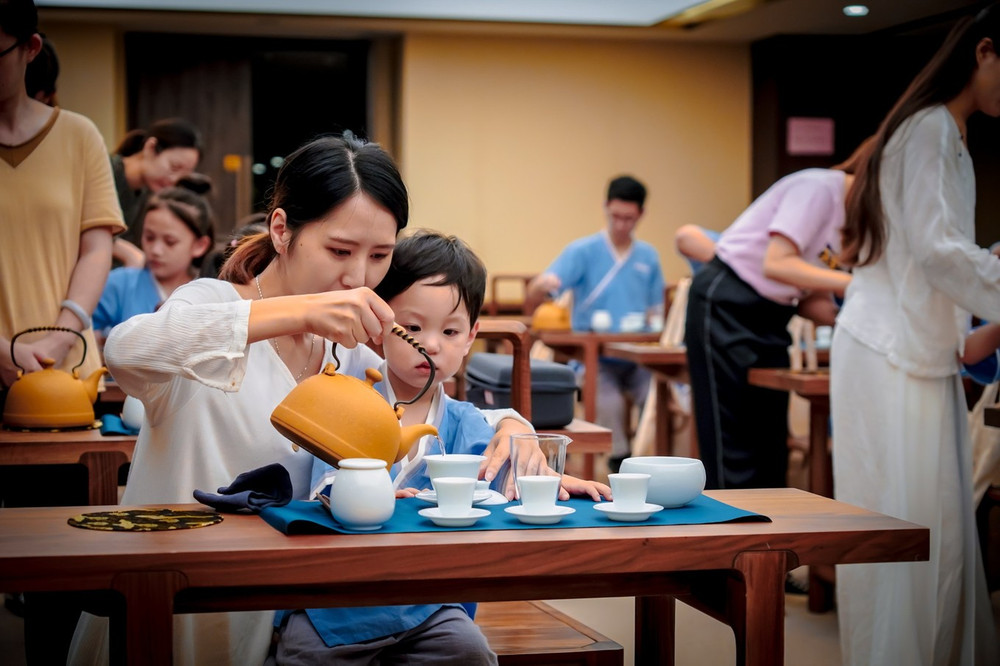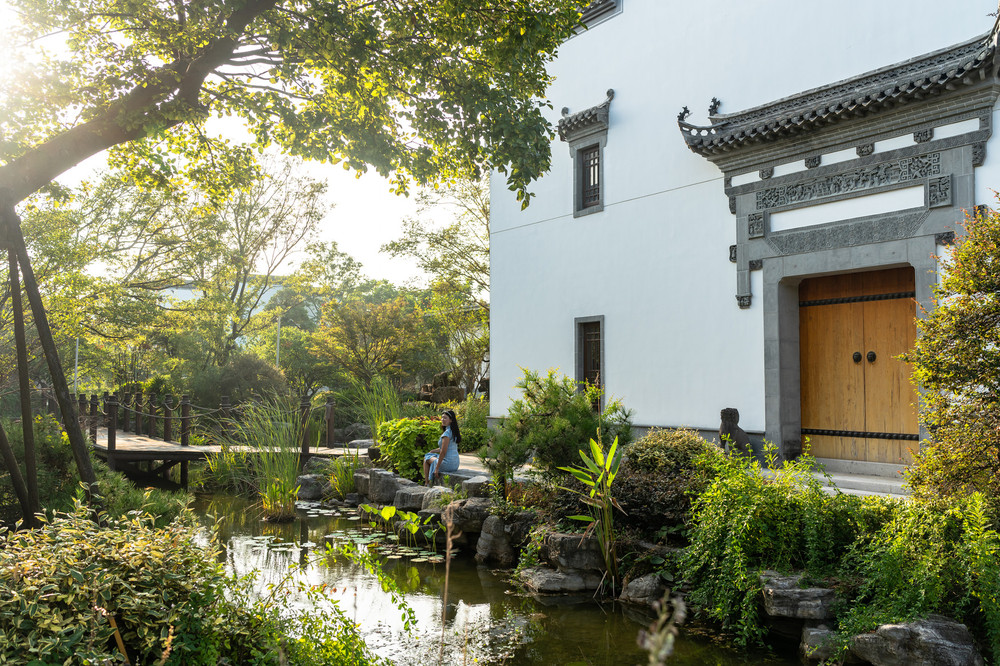Duration: 1 day. Time: January. Companions: Spouse. Activities: Self-driving, cultural exploration, free travel, hiking, budget travel, weekend getaway. Published on 2022-04-27 21:59. Destination: Shanghai Museum’s Ancient Chinese Ceramics Pavilion.

After viewing the special exhibition, we began our tour from the second floor with peace of mind. Although there were several exhibition halls on the second floor, it was only natural that I chose the ceramics pavilion, which I have always loved.
The invention of pottery is one of the important hallmarks of the Neolithic Age and was due to the emergence of primitive agricultural production at the time. Our ancestors began to settle down and thus learned to make pottery.
The cultural relics of China’s Neolithic Age are widely distributed. Even in the Jiangnan region, which I thought did not have a long history, there are multiple Neolithic relics, such as the Majiabang Culture and the Songze Culture. It can be imagined that as far back as the Neolithic Age, the making of pottery was almost everywhere in China.
The painted pottery bird pattern pot of the Majiayao Culture around 3800 BC has very typical primitive artistic characteristics. It is because of the Neolithic pottery that I have always felt that the civilization at that time was already very brilliant. Speaking of this pot, even in modern times, it would not be considered rough or outdated.
The red pottery basin-shaped ding of the Songze Culture from about the same period, although heavily corroded, can still see fine decorations on the body. The bronze ding of the later Shang and Zhou dynasties, in terms of style, also inherited this style to some extent.
Although the black pottery carved pattern pot with a lid of the Songze Culture has a relatively simple style, the exterior is polished and smooth, using a carved decoration method, and the entire pot is aesthetically pleasing. The decoration at the mouth of the pot is even more exquisite. This pottery is a grey body with a black glaze, made when the black of the kiln infiltrates the surface of the pottery, and the tiny pores on the surface of the vessel are filled with black smoke, forming a black exterior. This technique is also known as the carbon infiltration technique.
The black pottery high-handled pot with a lid of the Liangzhu Culture from 3100 to 3200 BC is completely black, with smooth lines, a straight mouth, a flat round belly, a high ring foot, and the ring foot has exquisite pierced patterns. The lid has a tall handle, and the overall shape is very aesthetically pleasing, with a smooth and shiny surface of the vessel. Since we visited the Liangzhu Culture Museum, I have always admired the jade-making skills of this period, but their level of pottery making is also quite high. It should be noted that black pottery is very thin, said to be only one millimeter, which would also be a treasure in modern society.
However, pottery is still far less exquisite than porcelain. Primitive celadon appeared in the Shang Dynasty, and the Zhejiang region is the earliest birthplace of Chinese porcelain. The shapes are mostly imitations of bronze ritual vessels, and there is a celadon string patterned zun that looks like a bronze vessel. Primitive celadon was prosperous in the Western Zhou, Spring and Autumn, and Warring States periods, and declined after the Western Han Dynasty. In terms of exquisiteness, primitive celadon may not be as good as the skilled black pottery.
In the Eastern Han Dynasty, mature celadon was successfully fired, and it further developed in the Wu State of the Three Kingdoms and the Western Jin Dynasty. The firing production area expanded during the Eastern Jin, Southern Dynasties, and Sui Dynasty, and the celadon industry in the north matured from the Northern Dynasties.
The Sui Dynasty’s colored glaze pottery camel belongs to tri-color pottery. The so-called Tang Sancai, which was actually fired from the Sui Dynasty, was later called Tang Sancai because it was extremely popular in the Tang Dynasty. The tri-color pottery of the Sui Dynasty is most characteristic of camels and horses, and so is Tang Sancai.Even in Jiangnan, which I once believed to be lacking a long history, there are numerous Neolithic relics, such as the Majiabang and Songze cultures. It’s conceivable that during the Neolithic Age, pottery making was widespread throughout China. The painted pottery pot with bird patterns from the Majiayao culture around 3800 BC is a prime example of typical primitive art characteristics. My encounters with Neolithic pottery have led me to feel that the civilization of that era was, in fact, quite brilliant. Take, for instance, this pot; even in modern times, it doesn’t appear rough or outdated.
The red pottery basin-shaped tripod from the Songze culture, dating from around the same period, is severely corroded, yet one can still discern fine decorations on its body. Later, the bronze tripods of the Shang and Zhou dynasties inherited this style to some extent. Although the black pottery engraved lid jar of Songze culture is relatively simple in style, its surface is polished smooth, featuring engraved decoration. The entire lid jar is aesthetically pleasing in shape, with a particularly delicate pattern at the mouth of the jar. This pottery is a gray-bodied, black-clothed variety, where the black color from the kiln penetrates the pottery’s surface during production. The tiny pores on the surface are filled by black smoke infiltration, resulting in a black appearance—a process known as carburizing technology.
The black pottery high-handled lid jar from the Liangzhu culture, dating back to 3100-3200 BC, is completely black with smooth lines, a straight mouth, a flat and round belly, a high ring foot, and fine hollowed-out patterns on the foot. The lid features a tall handle, and the overall shape is very beautiful, with a flat and shiny surface. Since visiting the Liangzhu Culture Museum, I have been deeply impressed by the jade-making skills of this period. However, it’s important to recognize that the pottery-making level of people at that time was also quite high. Black pottery is remarkably thin, said to be only one millimeter, and even in modern society, it is considered a treasure. Nonetheless, pottery is still far less exquisite than porcelain.
Primitive celadon first appeared in the Shang Dynasty, with the Zhejiang region being the earliest birthplace of porcelain in China. The shapes mostly imitated bronze ritual vessels, such as a celadon vessel with string patterns that closely resembles bronze ware.
Primitive celadon flourished during the Western Zhou, Spring and Autumn, and Warring States periods, and declined after the Western Han Dynasty. While it may not be as exquisite as skillfully made black pottery, mature celadon was successfully fired in the Eastern Han Dynasty. It further developed in the Wu State during the Three Kingdoms period and the Western Jin Dynasty. The firing areas expanded in the Eastern Jin, Southern Dynasties, and Sui Dynasty. Starting from the Northern Dynasties, the northern celadon industry became mature. The colored glazed pottery camel of the Sui Dynasty is an example of tricolor pottery. Tang Sancai, which began to be fired since the Sui Dynasty, became extremely popular in the Tang Dynasty and was then named Tang Sancai. The tricolor pottery of the Sui Dynasty, like Tang Sancai, is most characteristic of camels and horses. This camel has an upright posture and is fired very finely, with patterns at the joints of the camel’s body and even the goods carried on its back clearly fired.
The double-handled pot with cloth pattern from the Eastern Han Dynasty may represent a transition between primitive celadon and mature celadon. Its style is very simple; it’s just an ordinary pot that appears clumsy and heavy. Although some shapes are fired at the mouth of the pot, they are merely simple patterns. The celadon tiger-shaped vessel and celadon lion-shaped exorcising object from the Western Jin Dynasty seem smoother and more delicate, with more complex shapes and numerous patterns on the porcelain body.
Compared to the endless five-connected pots in later dynasties, the brown-glazed animal five-connected pot from the Eastern Han Dynasty is still relatively simple in style, although it has made significant progress compared to the pots and jars of the primitive celadon era. Museums display many five-connected pots, and generally, the later ones are more exquisite as people’s skills in firing porcelain have improved. Not only are there figure shapes on the pot body, but the patterns on the pot cover are more complex, featuring pavilions, terraces, figures, flowers, and birds—virtually everything.
The celadon figure pot with piled-up sculptures from the Wuzhou kiln in the Wu State during the Three Kingdoms period has a uniform glaze color. The animal shapes on the pot body are already very three-dimensional and vivid. However, although it is called a figure pot, we seem to only see two very three-dimensional circles of animals.In the Sui Dynasty, there had already appeared various forms of figurines. Most of them are female roles, holding pots, dancing, playing flutes, playing pipas… Most of them are maids or musicians. Terracotta figurines belong to ancient Chinese burial sculpture artworks. The owners of tombs are mostly men of noble status. It is understandable to bury these female figurines. There is a red terracotta female figurine listening to music of the Eastern Han Dynasty, which is made of muddy red pottery. Although the facial contours are not clear enough, the expression can be seen as pleasant, showing the feeling of the figurine when listening to music.
The production technology of colored glazed pottery in the Tang Dynasty advanced by leaps and bounds, and the porcelain industries in the south and north also developed rapidly. The celadon of Yue kiln in the south and the white porcelain of Xing kiln in the north were the top porcelain kilns of the two different porcelain systems in the south and north at that time. Tang Sancai is needless to say. Whether it is a tricolor camel or a tricolor horse, it enjoys an extremely high reputation internationally. Until today, it is still a popular gift for people to bring back when traveling to Shaanxi.
An assortment of pottery figurines and animal statues are equally impressive. With human figurines standing out for their rich colors, detailed attire, and expressive faces. A particular vase stands out for its unique color and shape, resembling a bird in its overall form. With the vase’s neck serving as the bird’s head and the body featuring a three-dimensionally crafted pattern. Although the white-glazed vase appears simple, its even glaze already indicates significant advancements in porcelain making. This type of vase was very popular during the Tang Dynasty, characterized by its small mouth, broad shoulders, and a large belly that can hold a lot.
The brown-glazed ewer from Changsha Kiln, despite its simple design, already features simple patterns fired onto the body. Changsha Kiln, mentioned in the ‘Complete Tang Poems’ by Li Qunyu in his poem ‘Shi Zhu’, is a famous Tang Dynasty kiln that pioneered the firing of high-temperature underglaze multicolored porcelain and established its position as the progenitor of high-temperature copper-red glaze porcelain.
The celadon four-handled pot from Yue Kiln has a regular shape, a full and grand body, pure glaze color, and even glaze application. Although its shape appears simple, it possesses a natural and simple beauty. The main characteristics of Yue Kiln celadon porcelain are its fine and dense body, even glaze layer, and a yellowish tinge to the blue color, requiring minimal decorative patterns.
The celadon ‘hai tang’ bowl from Yue Kiln features a four-petaled ‘hai tang’ shape, with a fine and dense body, covered in celadon glaze with a slight yellowish tint, and even and moist glaze. The ‘hai tang’ style bowl emerged in the late Tang Dynasty, named after the blooming ‘hai tang’ flower, and this shape imitates the金银ware shapes from the Sogdian region, but in my aesthetic view, it is more exquisite than the metalware.
The white-glazed ‘chuan dai’ pot from Xing Kiln is also simple in shape, with a very high whiteness, giving it a substantial and stable appearance. The ‘chuan dai’ holes on the shoulders and lower abdomen are for threading ropes, following the design of the skin bags from northern nomadic tribes, with a slightly different shape compared to the southern ones that only have upper straps. Xing Kiln’s white porcelain is very famous for its whiteness, earning it the reputation of being ‘like snow’ and ‘like silver’. Of course, Xing Kiln also fired celadon, black, and brown-yellow porcelains, but they are not as well-known as the white porcelain.
The white-glazed ‘lou diao’ palace figure pillow from the Five Dynasties has a fine and pure white body, completely covered in white glaze without any impurities. The pillow surface is engraved with intertwined flower patterns, dense but not chaotic, and the pillow body features a palace with clear doors, steps, and pillars. A palace door on the side is slightly open, with a person standing in front with their hands down, a design that is truly unique and ingenious.
The celadon ewer from Yuezhou Kiln in the Five Dynasties is simple in style and a bit peculiar in shape, with its head resembling a funnel or the upper half of an hourglass, and the spout is accordingly designed with a fold.
Bingzhou Kiln, also known as Xiangyin Kiln, began firing in the Eastern Han Dynasty, but by the late Tang Dynasty, it had exited the historical stage and was replaced by Changsha Kiln.
The ‘guan’ character carved lotus petal pattern jar withIt is said that the bottom of these pots is engraved with the character ‘official’, which can barely be seen in the small mirror below. Pots with the ‘official’ character are unique, while bowls or plates with the same character have been found in various places in the north and south. The plain embryo has a white color like congealed fat, just like the fairy palace brewing jade. The blue glaze is painted with powder, and the Jing Kiln is still waiting to cast new porcelain. – Seven Absolute









